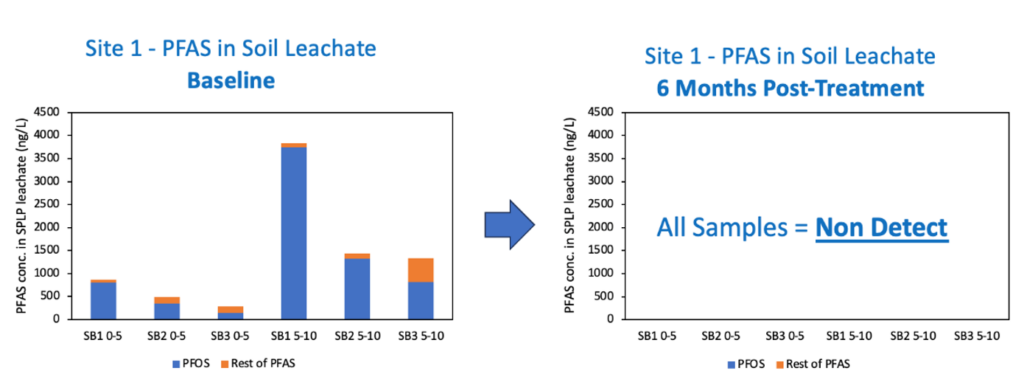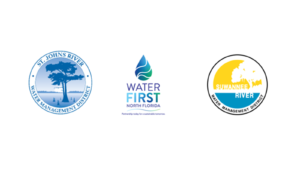By STEVE BARNES,
Remediation Services Director, REGENISIS
Two field pilot studies for treating PFAS source zones in situ were recently completed at firefighting training areas on Michigan (MI) and Washington (WA) aviation sites. The pilot test treatments incorporated SourceStop®, a new colloidal activated carbon (CAC) amendment for treating PFAS source zones, emplaced as a horizontal barrier to prevent PFAS leaching. Samples collected at both sites showed PFAS soil leachate concentrations reduced by more than 99 percent following treatment, while six-month post-treatment sampling at the MI site showed PFAS reduced to non-detectable levels. Similar results are expected at the WA site following the completion of the six-month sampling event.

PFAS source areas at two U.S. aviation facilities, Site 1 – MI and Site 2 – WA, were selected to implement the field pilot testing program. Repeated AFFF (aqueous film-forming foam) discharges had left high concentrations of PFAS in the shallow soils leaching to the underlying groundwater in the pilot test areas. The tests were conducted in 225-square-foot (ft) areas to a depth of 10 ft within more extensive areas of AFFF discharges (Figure 1). The applications targeted the vadose zone, ranging from four to six feet above the groundwater table.
Pre-treatment soil samples were collected, and leachate extracts were prepared using U.S. EPA’s SW-846 Test Method 1312: Synthetic Precipitation Leaching Procedure (SPLP), followed by analysis of PFAS by Method 537.1 to provide baseline PFAS leachate concentrations. The average/maximum PFAS concentrations in soil leachate were 1,376/3,835 nanograms per liter (ng/L) at Site 1 and 7,079/16,115 ng/L at Site 2. PFOS (perfluorooctanoic acid) comprised approximately 90% of the total PFAS detected at both sites.

Source soils were excavated from the target treatment area and temporarily stockpiled on the adjacent ground surface at each pilot test location. The topsoil layer was segregated for later use during site restoration.
After reaching the bottom excavation depth (10 ft), the SourceStop CAC horizontal barrier was spray-applied, ensuring an even coating of the excavation bottom and sidewall bottom edges, while allowing the material to infiltrate the underlying undisturbed soils.
Following the CAC horizontal barrier installation, stockpiled soil was placed back into the open excavation in-2.5-to-4 ft-thick lifts, along with a prescribed CAC/powdered activated carbon (PAC) amendment blend.
These materials were thoroughly mixed into the soils using an excavator bucket or a rotary mixing head until achieving a homogeneous consistency. Each completed lift was graded flat and compacted with a small trench compactor.
During treatment, representative samples were collected from test cells within treated lifts and analyzed for PFAS leachate in soil per the above-described laboratory methods to provide a snapshot of treatment efficacy. Following treatment, the site work area was restored using the segregated topsoil vegetation as the final surface cover, which was re-seeded and protected with straw erosion control matting.

PFAS concentrations in soil leachate were reduced by 99.4% at Site 1 and 99.5% at Site 2 in samples collected post-treatment (Figure 2). At Site 1, samples were collected after six months and no PFAS were detected, demonstrating a 100% PFAS removal efficiency (Figure 3). A six-month post-sampling event is scheduled for completion in the summer/fall of 2023 at Site 2.
Across thousands of sites worldwide, PFAS source areas serve as substantial repositories of contaminants, resulting in the leaching of PFAS and the formation of expansive plumes of groundwater contamination. The pilot tests completed at two prototype AFFF-release sites resulted in the total and sustained elimination of PFAS in soil leachate, demonstrating how these PFAS sources can be rapidly and effectively mitigated.

The in situ PFAS source treatments apply accelerated sorption kinetics to rapidly halt PFAS contaminant plume development and prevent impacts to downgradient receptors. The SourceStop CAC horizontal barriers emplaced at the base of the treatment zones significantly improve PFAS retention over commodity carbon materials like PAC, providing a highly effective, long-term solution to prevent PFAS leaching.
The sustainable remediation approach demonstrated by these pilot tests can be flexibly applied to vadose zone soils, the capillary fringe, and groundwater at PFAS source areas to meet site-specific needs. Combining PFAS source zone treatments with CAC barrier treatments (i.e., PlumeStop®) in the plume body can serve as a permanent solution to reduce PFAS exposure risks, replacing non-sustainable, waste-generating, and costly remedial approaches like dig & haul or pump & treat that further degrade the environment.





















